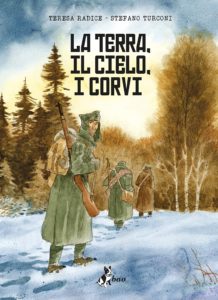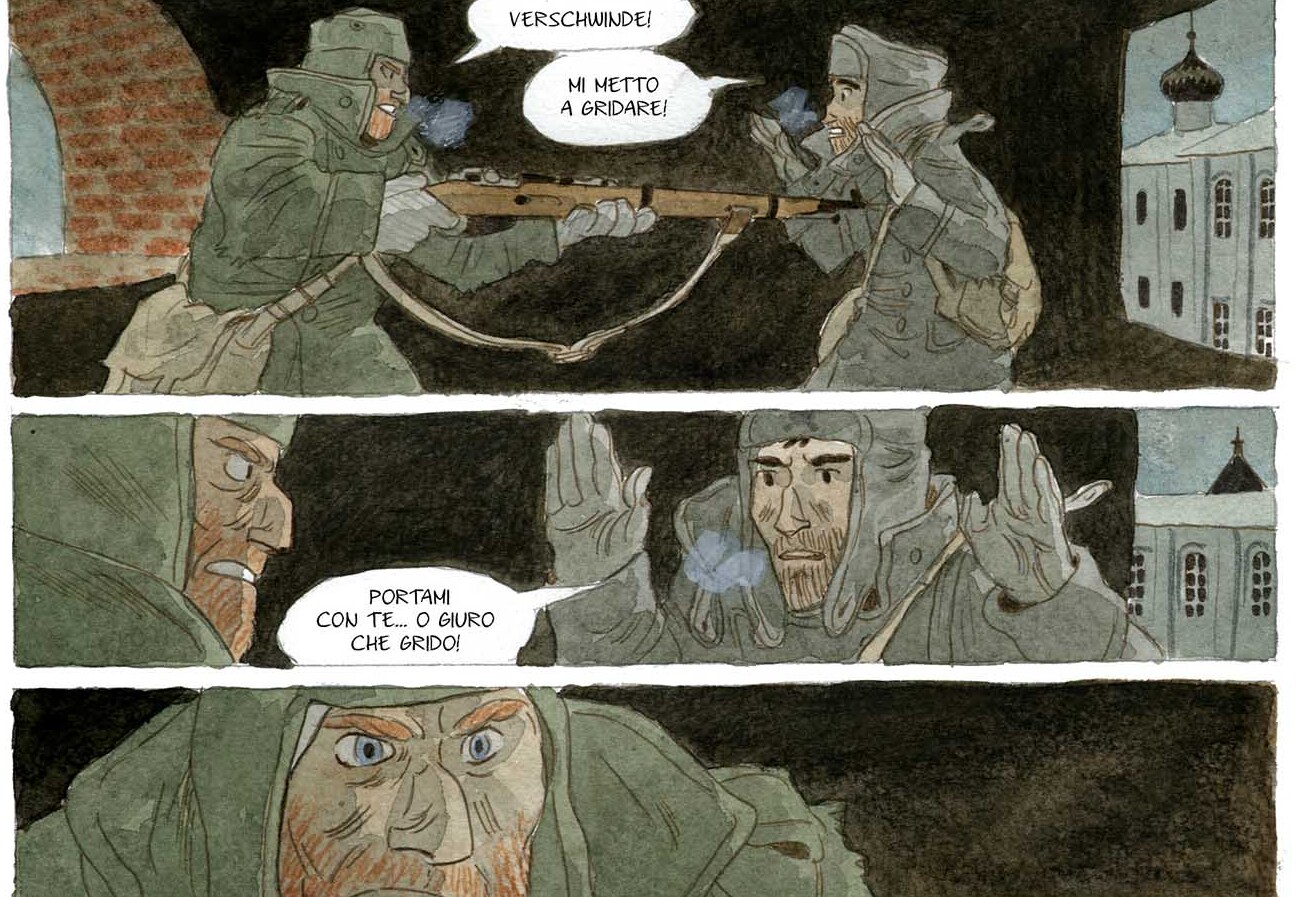Translated into multiple languages, the graphic novels written by Teresa Radice and drawn and colored by Stefano Turconi delve into history and geography, telling heart-moving stories, like the one of a Syrian refugee going through hardship to reach her lover in Italy (“Non Stancarti di Andare”, or “Don’t Get Tired of Going”), to displacement during the second world war (“La Terra, Il Cielo, I Corvi”, or “The earth, the sky, the crows”).
In the work of the creative duo – a couple in life as well as in art – imagination meets the most timely issues of our time. Creating memorable characters in dense and emotionally challenging graphic novels, Radice and Turconi aim to destroy barriers and show how to love unconditionally. To readers, their work is solace for the spirit.

Their creative community of four – which includes a daughter and a son – lives in Northern Italy in the so-called “House without a North”.
“It’s our house but also our creative place.” Indeed, their life and work are deeply intertwined. “Telling stories is the only way we know how to inhabit the world. It’s inevitable that in one’s oeuvre there is something that is deeply their own, the places they love, the people they met disguised as someone else,” says Teresa Radice.
“In the end, the need to recount always comes from something that you have lived, even in the case of fantasy stories. Otherwise, it’s pure mechanics.”
Turconi and Radice met at Disney – which bases a big part of its production in Italy. The vision that manifested their current life came quite naturally to them:
“We don’t think too much, we’d rather use our intuition a lot. We always had common interests, like traveling, the mountain, so these interests naturally come into our stories. Our outlook on life gradually started coming out more and more in our books.”
Their latest book is called “La terra, Il Cielo, I Corvi”. Published in Italy by Bao Publishing, it is the story of an Italian, a German, and Russian soldier set in the winter of 1943 with the atmospheres of the great Russian masters. Their story is both individual and choral, and the tables in watercolor are masterful and beautiful.
To readers, their work is solace for the spirit.
For this book, like all their other creations, it all starts with Radice writing the story, which will be later developed in an actual scenario that includes dialogues. That’s what Stefano will base his drawings on: “We always know the start and the end of the story. What we might not know it’s what’s happens in between.”
“When we are working we are always completely immersed,” says Turconi. “We can spend one or two years reading everything we can on a certain setting, before starting to tackle the process. We read a lot of Patrick O’ Brian for ‘The Forbidden Harbour’ and Tolstoy for ‘La Terra Il Cielo e I Corvi’. We also like to gather visual documentation in advance, so that you just need to pick and choose what you need for a certain story or a certain moment.”
For La Terra Il Cielo I Corvi, Stefano gathered a lot of visuals on the uniforms and the means of transportation from the time the book is set in. “As a reader, I don’t like when uniforms aren’t precise or there are objects that couldn’t possibly exist at the time,” says Turconi. “That’s why as authors we try to be as precise as possible. We often speak about places we have visited ourselves.”

In “La Terra Il Cielo e I Corvi”, the action starts in some monasteries in Russia that they visited.
“We knew what was around the place, we got a taste for the atmosphere, and that really helps,” says Turconi. “‘Non Stancarti di Andare’ is set in Syria because we visited there, and that was something we experienced. We gather photobooks, illustrators’ books, we watch movies…”
In terms of aesthetic inspiration, Rien Poortvliet has been the main inspiration source for the use of watercolors in “La terra, Il Cielo, I Corvi.” Turconi has in fact many authors from the past in his DNA: “I’m not 100% following the contemporary comics scene. I grew up with the French comics of Asterix. I have always loved them, along with Disney, and Italian authors of adventure comics from the ‘70s. These are the basis for building everything else, but then of course depending on the moment I look at different authors.”
For Teresa Radice, while she loves contemporary comic authors, her references are in a different field: “I appreciate them but they don’t have much to do with the way I personally write. I mostly love writers and poets. I usually read authors connected to what I’m writing at the moment. For example I started to read Tolstoy for this latest work. So I don’t have a single reference point.”
With the pandemics and the ever-changing regulations in Italy, the couple had a hard time establishing a working routine. Radice says that the only real rule was to start working when the kids went to school and carry on until they went fetch them. “For me, the hardest part is when I’m writing the story and the scenario. Then the most relaxing part is transfering everything from my handwritten notes on notebooks to the computer. That’s the version Stefano will work on.”
When he is in full mode, Stefano can do even two pages a day. “Now I try to always work on the same thing, in the sense that I don’t do maybe two hours on the comics and another three on an illustration. I try to avoid this. I’ll try to do maybe one week on a book, another week on another, rather than switch multiple times during the day.”
Turconi, who used to be a teacher at a Comic School, says his first suggestion for young artists is to not look at other comics too much: “Look at inspiration from other sources, like photography, literature, illustration, art, paintings. If you look at other comic book authors too much, you end up becoming their clone. And also never try to do manga comics! Kids love them, but outside Japan, the manga market is virtually non-existent. And finally, don’t be afraid of copying. Copy a lot.”
Teresa advises young comic book authors to hold on and keep going if they deeply feel this is their path: “If one has a path that is screaming inside them they must follow it. That’s what happened to me. I wanted to write stories, it didn’t matter if it was traditional literature or comic books. It might look stubborn, but eventually, that’s what I ended up doing today. I believe it’s true for all jobs, creative or not. However, even your dream job has hard moments, it’s not all smooth sailing. You need focus, determination, concentration, and patience.”
Image credits: Bao Publishing

